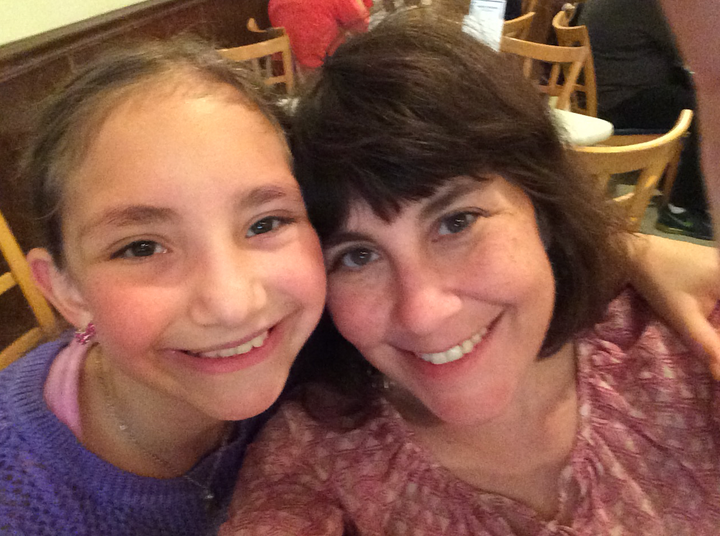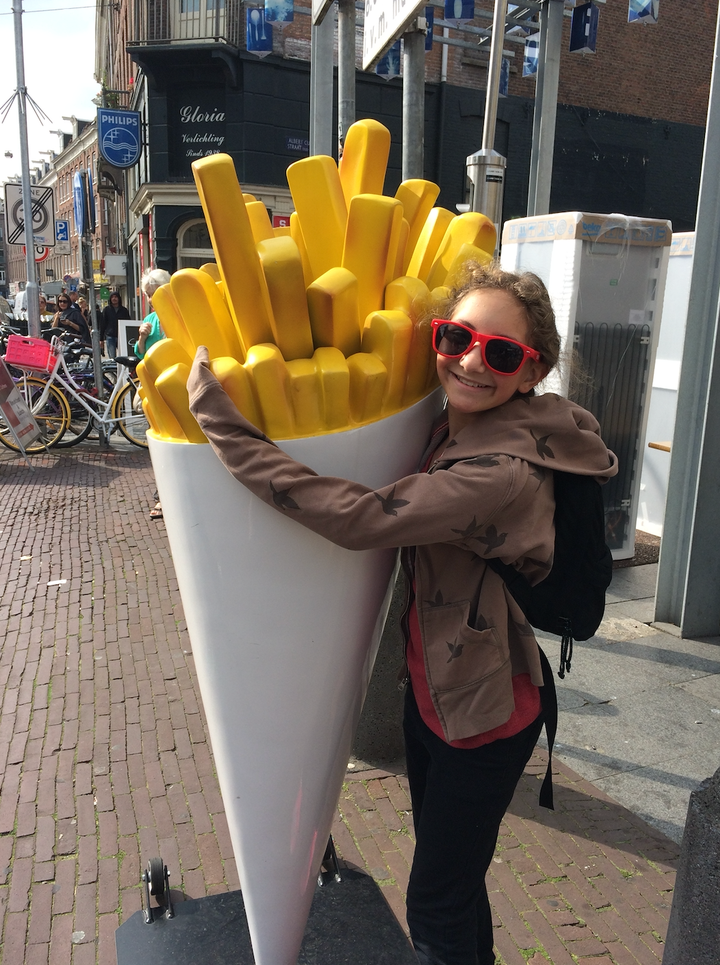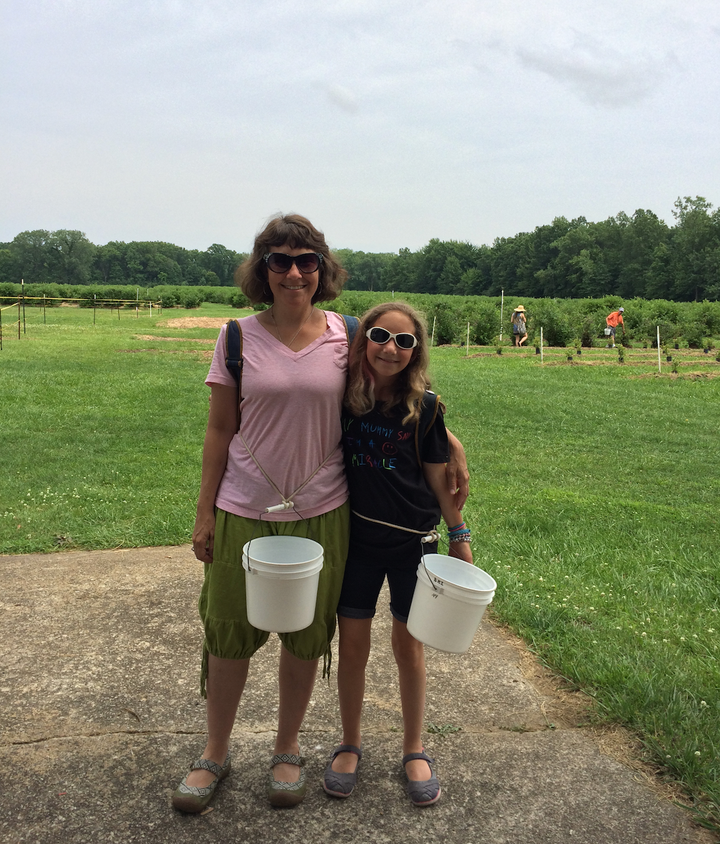
In a home video from my 12 birthday, my family is seen celebrating at a pizza place in the hour between Hebrew School and my violin lesson. My father, holding an enormous, shoulder-mounted video camera, has zoomed in on my chocolate birthday cake. As the camera pans up to my face, grinning while my family sings “Happy Birthday,” I sink the knife into the frosting. From somewhere behind the camera, a monologue becomes audible. It’s my mom, who chose this restaurant specifically for its salad bar, chanting, “I’m going to be GOOD today. I’m not having ANY. Not even a taste. I’m being GOOD.”
Just barely visible in the way I hesitate as I cut that first slice is the thought crossing behind my eyes: If being good is not having any cake, what does it mean to have some?
I was the mother of two girls when I watched this video again more than 30 years later. Though I wanted desperately for them to grow up with different attitudes about food than the ones I’d witnessed, it became complicated when my younger daughter, Sammi, was born with a mess of gastrointestinal issues ― gastro-esophageal reflux, esophageal dysmotility, and eosinophilic esophagitis ― that limited her diet in strange new ways every few years.
When she was a toddler, she couldn’t eat citrus, chocolate or tomatoes. When she was in kindergarten, we spent a year carefully removing and then reintroducing dairy, eggs, soy, nuts and wheat. She had real struggles with textures and swallowing. Despite everything, I worked hard to create a vocabulary that didn’t demonize a particular food or food groups.
First of all, we used “safe for Sammi” to describe the foods she could eat and we arranged for my older daughter, Ronni, to have opportunities to eat the foods she loved that weren’t “safe.” Both girls seemed to understand the foods we had to eliminate were not inherently bad and wouldn’t hurt us if our family started eating them again if and when they were safe for Sammi. It took constant conversation and frank descriptions of the medical reasons behind every new regimen to keep self-righteousness out of the equation.
On the bright side, necessity forced us to try many new foods over the years ― being open-minded about unfamiliar foods became the virtue we prized most. We made a point to taste new things, to experiment and expand our palates. On every trip to a new grocery store, we each tried to pick a food we’d never had. As a result of these explorations, by the time my daughters were 11 and eight, they loved foods like beet salad and tofu as much as they loved homemade cookies and fast food French fries.

I had finally begun to relax about food when, after Sammi underwent cardiac surgery at eight years old ― to disentangle her esophagus and aorta ― we learned we were about to be hit with the worst diet yet.
Because the surgeon had nicked a thoracic duct in her chest cavity during the procedure, Sammi’s body temporarily could not process almost any dietary fat. That meant any dietary fat ― saturated, unsaturated, natural or otherwise. The small leaks in her thoracic ducts, which process dietary fat, would have meant fat cells oozing into her chest cavity if she ate any. For six weeks, she had to eat a totally fat-free diet.
Though she could eat vegetables and fruits and some legumes, just getting calories into her was hard. In a desperate effort to appeal to her appetite without compromising her safety, I filled my house with the foods of my adolescence: jello and frozen grapes, fat-free butter spray, fat-free cheese slices, skim milk and, worst of all, packaged fat-free fudge cookies. As a teen, my brother and I had snuck those gummy, chemical-smelling cookies from our kitchen. I can still picture my mother standing in front of the fridge under the “Nothing tastes as good as being thin feels!” sign, scolding us, with tears in her eyes: “Those are the only cookies I can eat!”
Now I was putting them in my 8-year-old daughter’s lunch for school. It made me shudder.
Eating a diet with no fat in it isn’t just unpleasant. It can cause changes to brain chemistry, and Sammi was no exception. Human brains need dietary fat in order to manage the mood-enhancing effects of serotonin; without any fat in her diet, Sammi’s brain was missing the means to regulate not just mood but cognition.
One afternoon, I got a call from her Hebrew school telling me she was highly agitated. I raced to the synagogue to pick her up, leaving a cart full of fat-free groceries in the aisle of the supermarket.
As I entered the school, I could already hear Sammi’s loud, panicked wailing. She was with Ronni, who was hugging her and stroking her back. Sammi’s red eyes widened as she looked at me and sobbed, “Mommy, I ate fat! Am I going to die?”
In two steps, I had them both in my arms and was calling the number for the heart surgeon.

Quickly, I learned Ronni had forgotten about Sammi’s fat-free diet and let her take a few bites of her cheese pizza. I didn’t know how to answer Sammi’s question; as the ducts in her chest attempted to process the fat molecules from pizza, the holes in each duct could leak white, milky fluid into the cavity around her lungs. I flashed back to the hospital, remembering the drainage tube they’d removed from her chest before she’d been discharged. Without the tube, how long would it take for the fat to drown her?
The doctor, thankfully, felt those few bites would probably be safe, but we had to wait several days and watch Sammi’s breathing carefully to be sure we were totally in the clear. As we waited, the world around us abounded with misunderstanding of what a fat-free diet really meant.
One morning, after I’d fed Sammi a breakfast she’d barely touched, a school administrator who knew my daughter’s medical challenges stopped us in the hall.
“How’s that diet going?” she asked, looking down at Sammi’s head.
“It’s awful,” I answered for her, my hand on her shoulder. Sammi squeezed my other hand in hers.
“You know, Sammi,” the administrator said, crouching down, “You should tell me all the things you’re eating these days. I should be eating like you! I need to lose all this weight I’ve gained. Tell me ― what are you eating?”
I let go of Sammi’s hand and wrapped both of my arms across her chest. “No,” I said. “That’s not healthy. It’s not good for anyone to eat like this unless they absolutely have to. It’s not good for your brain. Sammi’s done in three weeks and we’re very, very glad.”
With that, I walked my tired, hungry and unhappy daughter past her. During the subsequent weeks, this scene would repeat itself with other adults. I made sure my daughters saw me react with conviction and, if pushed, vitriol. I would not normalize this diet for them.
Fortunately, Sammi’s thoracic ducts healed and closed, no worse for the few bites of pizza. Now, five years later, there are always Oreos and tortilla chips in my kitchen. There are also mangoes and lentils and piles of vegetables. Living with restrictions for so many years made me defiant: Nothing is forbidden.
“I can only hope that, as they continue to engage with the world outside our home ― full of impossible expectations about how women are supposed to look and feel about themselves and the fare on their plates ― they will remember how I taught them to approach food and eating with joy.”
More importantly, I can feel a powerful shift from the 1980s culture of deprivation which shaped my adolescence to the calm I feel about attitudes in my own home. While around us, diet culture rages even as it shifts its focus from fat to carbohydrates to the latest fad, in my house, we view food as a beautiful gift of fuel and pleasure. I am incredibly grateful that, despite the years when Sammi’s health could have upended my plan for moderation in our language about food, both my daughters ― now teenagers ― have maintained generous palettes and good attitudes toward the food they eat.
Of course, no matter how positive or encouraging I am as a parent, it might not always be enough to stop the overwhelming tide of negative cultural messaging that they encounter about food and diet. But, the harder I fight to provide a smart, non-judgmental example for them every day, the better the chances of them rebuffing those messages.
For me, personally, it certainly isn’t always easy. I’m torn between generations: the one above me doing its best to pursue perfection, and the one below me, my perfect-as-they-are daughters who delight in their meals without guilt. What I see most is the happiness that comes from their treasuring every bite ― because it was forbidden before and now is allowed, or because it is simply delicious ― and not conflating some kind of calorie/fat/carbohydrate count with their value as human beings. They’re good. End of sentence.
I can only hope that, as they continue to engage with the world outside our home ― full of impossible expectations about how women are supposed to look and feel about themselves and the fare on their plates ― they will remember how I taught them to approach food and eating with joy. I won’t be able to influence them forever, but I hope I’ve provided a foundation that lets them go out into the world and be healthy and happy about their choices.
In addition, I had a surprise lesson of my own. Because I decided to model an emotionally healthier path for my daughters instead of listening and, especially, repeating the voice in my head that told me I wasn’t being “good” if I ate that serving of French fries, it turned out that I said the right thing enough times that I finally believed it myself. I’ve long banished the word “good” from any language describing eating habits. My daughters watched me, as all children watch their parents, to see that my culinary joy comes from fresh sugar snap peas and flavorful curries and root beer, equally delicious and equally worthy of every swallow.
Debi Lewis is a writer from Evanston, Illinois. Her work has appeared in Kveller, ScaryMommy, Brain Child, The Mighty, and more, and she is at work on a memoir about parenting her daughter through medical mystery. You can find her on twitter at @GrowTheSunshine and by visiting her website, DebiLewis.com.
Do you have a compelling personal story you’d like to see published on HuffPost? Find out what we’re looking for here and send us a pitch!
